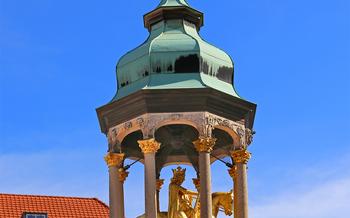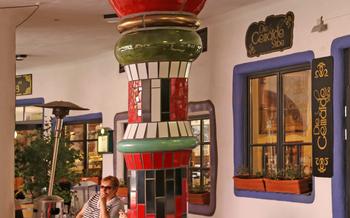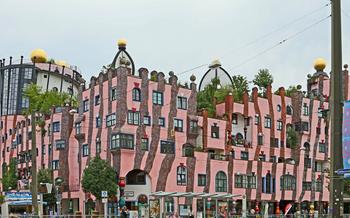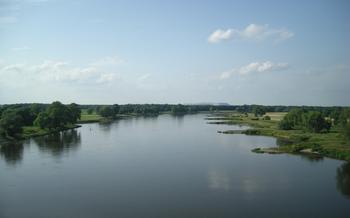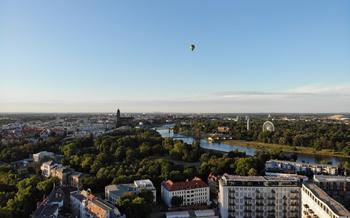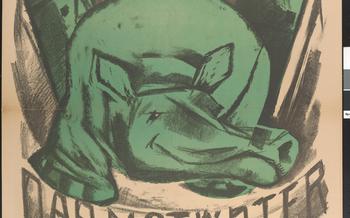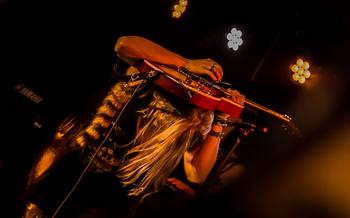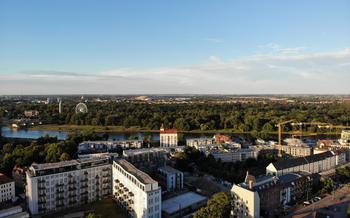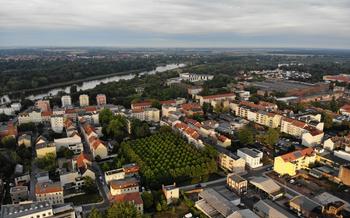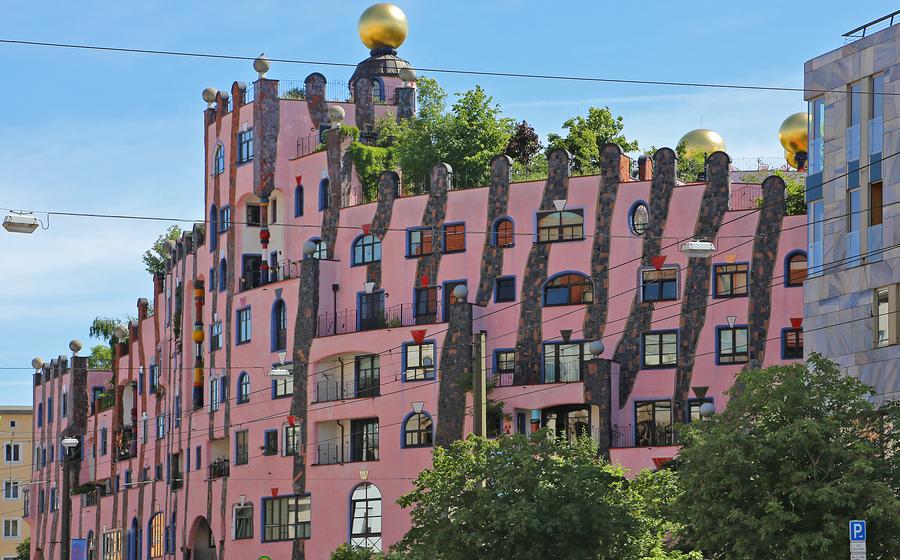
Hundertwasserhaus
- Hundertwasserhaus: A Unique Architectural Marvel
- History and Inspiration Behind the Building
- Location and Accessibility
- Guided Tours and Admission Fees
- Exploring the Facade and Courtyard
- Visiting the Café and Gift Shop
- Hundertwasser's Influence on Magdeburg
- Other Hundertwasser Projects in Germany
- Accommodation and Dining Options
- Magdeburg for Art Enthusiasts
- Day Trips from Magdeburg
- Planning a Visit to Magdeburg
- Photography and Social Media
- Insider Tip: Hidden Rooftop Garden
Hundertwasserhaus: A Unique Architectural Marvel
The Hundertwasserhaus, nestled in the heart of Magdeburg, Germany, stands as a testament to the visionary genius of Austrian artist and architect Friedensreich Hundertwasser. This extraordinary building, a collaborative effort with architect Peter Pelikan, embodies Hundertwasser's unique architectural style, characterized by vibrant colors, undulating lines, and intricate mosaics.
Hundertwasser's philosophy of "organic architecture" emphasized harmony between nature and the built environment. The Hundertwasserhaus reflects this philosophy, seamlessly blending art and architecture. Its colorful facade, adorned with ceramic tiles and mosaics, depicts a whimsical tapestry of human figures, animals, and plants, creating a sense of playfulness and wonder.
The building's undulating lines and curved balconies mimic the organic forms found in nature, evoking a sense of movement and fluidity. The rooftop, accessible to visitors, offers panoramic views of the city and features a lush garden with trees, flowers, and sculptures, further blurring the boundaries between architecture and nature.
History and Inspiration Behind the Building
Friedensreich Hundertwasser, the renowned Austrian artist and architect, conceived the Hundertwasserhaus as a manifestation of his philosophy of "organic architecture." He believed that buildings should harmonize with nature and reflect the individuality and creativity of their inhabitants. Collaborating with architect Peter Pelikan, Hundertwasser designed the building to embody these principles, integrating nature and art seamlessly.
The facade of the Hundertwasserhaus is a vibrant tapestry of colors and forms, adorned with intricate mosaics, ceramic tiles, and sculptures. Each element holds symbolic meaning, representing Hundertwasser's vision of a world where humans and nature coexist in harmony. The undulating lines and organic shapes of the building evoke a sense of fluidity and movement, blurring the boundaries between architecture and nature.
Hundertwasser believed that architecture should be a joyful and life-affirming experience, reflecting the diversity and vitality of the human spirit. The Hundertwasserhaus embodies this philosophy, inviting visitors to explore its hidden corners, discover its symbolic elements, and immerse themselves in a world where imagination and creativity reign supreme.
Location and Accessibility
The Hundertwasserhaus is conveniently located in the heart of Magdeburg, at Breiter Weg 10, 39104 Magdeburg, Germany. Its central location makes it easily accessible by various modes of transportation. Visitors can take advantage of the city's efficient public transportation system, with tram lines 1, 4, 5, and 6 stopping nearby. For those traveling by car, parking is available in the adjacent streets or in nearby parking garages. Whether you choose to walk, take public transportation, or drive, the Hundertwasserhaus is easily accessible, inviting you to immerse yourself in its unique architectural charm.
Guided Tours and Admission Fees
Guided tours of the Hundertwasserhaus offer an in-depth exploration of the building's history, architecture, and symbolism. Conducted in German and English, these tours provide fascinating insights into the mind of Friedensreich Hundertwasser and the unique concepts behind his creation. Advance booking is recommended, especially for group tours, to ensure a spot and avoid disappointment.
Admission fees vary depending on the type of ticket purchased. Adults can expect to pay a standard fee, while students and children are eligible for discounted rates. Family tickets are also available, offering a cost-effective option for families with multiple members. It is advisable to check the official website or contact the Hundertwasserhaus directly for the most up-to-date information on admission prices and tour schedules.
Exploring the Facade and Courtyard
The Hundertwasserhaus is a visual feast that demands exploration from every angle. Its vibrant facades are adorned with thousands of colorful ceramic tiles, mosaics, and intricate patterns, creating a kaleidoscope of colors and textures. Discover hidden details and sculptures embedded in the facade, such as whimsical figures, animals, and even a replica of the artist's own hand.
Step into the courtyard to immerse yourself in a tranquil oasis amidst the urban landscape. A unique fountain designed by Hundertwasser himself takes center stage, surrounded by lush greenery and colorful plants. Admire the harmony between nature and architecture as the building seems to blend seamlessly with its surroundings.
Visiting the Café and Gift Shop
After exploring the exterior of the Hundertwasserhaus, step inside to discover its charming café and gift shop. The café, located on the ground floor, invites visitors to relax and soak in the unique atmosphere of the building while enjoying a cup of coffee, tea, or a light snack. The menu features a variety of beverages and treats, including homemade cakes and pastries.
The gift shop, also on the ground floor, offers a delightful array of souvenirs, art prints, and books related to Friedensreich Hundertwasser. Here, visitors can find a treasure trove of items inspired by the artist's distinctive style and philosophy. From colorful postcards and magnets to limited-edition prints and books, the gift shop provides an opportunity to take a piece of the Hundertwasserhaus experience home.
Hundertwasser's Influence on Magdeburg
The Hundertwasserhaus has had a profound impact on the cultural landscape of Magdeburg. The building's unique design and vibrant colors have revitalized the Breiter Weg district, transforming it into a vibrant and artistic hub. The Hundertwasserhaus has also played a significant role in establishing Magdeburg as a center for contemporary art and architecture.
The building's popularity has attracted visitors from around the world, contributing to Magdeburg's growing reputation as a cultural destination. The Hundertwasserhaus has become an iconic symbol of the city, representing its commitment to creativity and innovation.
The success of the Hundertwasserhaus has inspired other architectural projects in Magdeburg that embrace unconventional design and sustainable principles. This has led to a more diverse and dynamic urban environment that reflects the city's evolving identity as a modern and forward-thinking cultural center.
Other Hundertwasser Projects in Germany
Beyond Magdeburg, Hundertwasser left his artistic mark on other cities in Germany, each project showcasing his unique architectural style. In Darmstadt, the Waldspirale residential complex resembles a giant snail shell, featuring colorful facades and spiraling walkways. In Kassel, the Märchenhaus, or Fairy Tale House, is a whimsical interpretation of traditional German architecture, adorned with ceramic tiles and intricate mosaics.
In Plochingen, the Hundertwasserbahnhof, or Hundertwasser Train Station, is a captivating fusion of art and functionality. Its vibrant colors and undulating forms transform the station into a captivating landmark. These projects not only exemplify Hundertwasser's architectural vision but also contribute to the cultural diversity and artistic landscape of Germany.
Discovering these hidden gems offers travelers an opportunity to delve deeper into the world of Friedensreich Hundertwasser and appreciate the breadth of his creative genius.
Accommodation and Dining Options
To make the most of your stay in Magdeburg, consider booking accommodation near the Hundertwasserhaus. The city offers a range of hotels and guesthouses to suit different budgets and preferences. For a truly immersive experience, opt for a hotel with a view of the Hundertwasserhaus, such as the Maritim Hotel Magdeburg or the Best Western Hotel Magdeburg.
When it comes to dining, Magdeburg has a culinary scene that will satisfy every palate. From traditional German cuisine to international flavors, there are plenty of restaurants to choose from. For a taste of local specialties, head to one of the many restaurants in the Breiter Weg district, such as the Ratskeller Magdeburg or the Brauhaus Pfaffer. If you're looking for a more upscale dining experience, try the Restaurant 100wasser, located within the Hundertwasserhaus itself, which offers a unique culinary journey inspired by Hundertwasser's art and philosophy.
Magdeburg for Art Enthusiasts
Magdeburg offers a plethora of art-related attractions beyond the Hundertwasserhaus, catering to diverse artistic interests. The Moritzhof Art Center, housed in a former monastery, is a vibrant hub for contemporary art exhibitions, performances, and workshops. Its diverse program showcases works by local, national, and international artists, spanning a range of mediums and styles.
The Kunsthalle Magdeburg, located in the city center, presents a rich collection of modern and contemporary art. Visitors can admire works by renowned German artists, such as Otto Dix and Karl Schmidt-Rottluff, as well as international masters like Pablo Picasso and Joan Miró. The Kunsthalle also hosts temporary exhibitions featuring emerging artists and specific themes.
Throughout the year, Magdeburg plays host to various art festivals and events that celebrate and promote artistic expression. The "Magdeburg Art Week" in September transforms the city into a vibrant canvas, with open studios, exhibitions, and workshops taking place across the city. The "Magdeburg Illumination Festival" in October illuminates the city's streets and landmarks with stunning light installations, creating a magical atmosphere.
With its diverse art scene and rich cultural heritage, Magdeburg offers a captivating experience for art enthusiasts, inviting them to immerse themselves in creativity and artistic inspiration.
Day Trips from Magdeburg
Magdeburg's central location makes it an ideal base for exploring the surrounding region. Several charming destinations are within easy reach, offering a diverse range of attractions and experiences.
For those interested in history and culture, a visit to the ancient city of Quedlinburg is a must. This UNESCO World Heritage Site boasts a well-preserved medieval town center, featuring half-timbered houses, historic churches, and a magnificent castle.
Nature enthusiasts will delight in the nearby Harz Mountains, a picturesque region renowned for its stunning scenery, hiking trails, and outdoor activities. Take a cable car ride to the summit of the Brocken, the highest peak in the range, and enjoy breathtaking panoramic views.
For a unique artistic experience, visit the Hundertwasserhaus in Halberstadt, another architectural masterpiece by Friedensreich Hundertwasser. This colorful and whimsical building is a testament to the artist's distinctive style and philosophy.
If you prefer a more urban destination, head to Leipzig, a vibrant city with a rich cultural heritage. Explore its historic center, admire its impressive architecture, and visit its numerous museums, theaters, and galleries.
Planning a Visit to Magdeburg
When planning your visit to Magdeburg, consider the best time to experience the city's charm. The spring and summer months, from April to September, offer pleasant weather for exploring the city's outdoor attractions, including the Hundertwasserhaus. Keep in mind that Magdeburg's winters can be cold and snowy, so be prepared with appropriate clothing if visiting during this time.
To make the most of your trip, consider combining a visit to the Hundertwasserhaus with other activities that Magdeburg has to offer. The city boasts a rich cultural scene, with numerous museums, theaters, and galleries to explore. Take advantage of the opportunity to immerse yourself in Magdeburg's history and vibrant arts community.
For a comprehensive experience, plan an itinerary that allows you to explore the city's various facets. Allocate sufficient time to admire the Hundertwasserhaus, stroll through the historic Old Town, and visit other cultural attractions that capture your interest. By combining these elements, you'll create a memorable and fulfilling visit to Magdeburg.
Photography and Social Media
Don't miss the opportunity to capture the whimsical essence of the Hundertwasserhaus through your lens. The colorful facades, intricate patterns, and unique architectural details provide an endless source of inspiration for photographers. Share your stunning shots on social media using hashtags like #Hundertwasserhaus, #Magdeburg, and #OrganicArchitecture. Your photos will not only showcase your artistic eye but also contribute to the visual narrative of this extraordinary building.
Insider Tip: Hidden Rooftop Garden
Beyond the vibrant facade and enchanting courtyard, the Hundertwasserhaus holds a secret gem—a hidden rooftop garden. This serene oasis offers a unique perspective of the city and the surrounding landscape. Adorned with lush greenery, colorful flowers, and whimsical sculptures, the rooftop garden exudes a tranquil atmosphere, inviting visitors to escape the hustle and bustle of the city below.
While not always accessible to the public, it's worth inquiring at the information desk about the possibility of visiting the rooftop. If you're fortunate enough to gain access, you'll be rewarded with breathtaking views of Magdeburg's cityscape, the winding Elbe River, and the distant spires of the city's cathedral.
Remember to bring your camera to capture the panoramic vistas and the charming details of the garden. The rooftop garden is a hidden treasure that adds another layer of enchantment to the already extraordinary Hundertwasserhaus.
